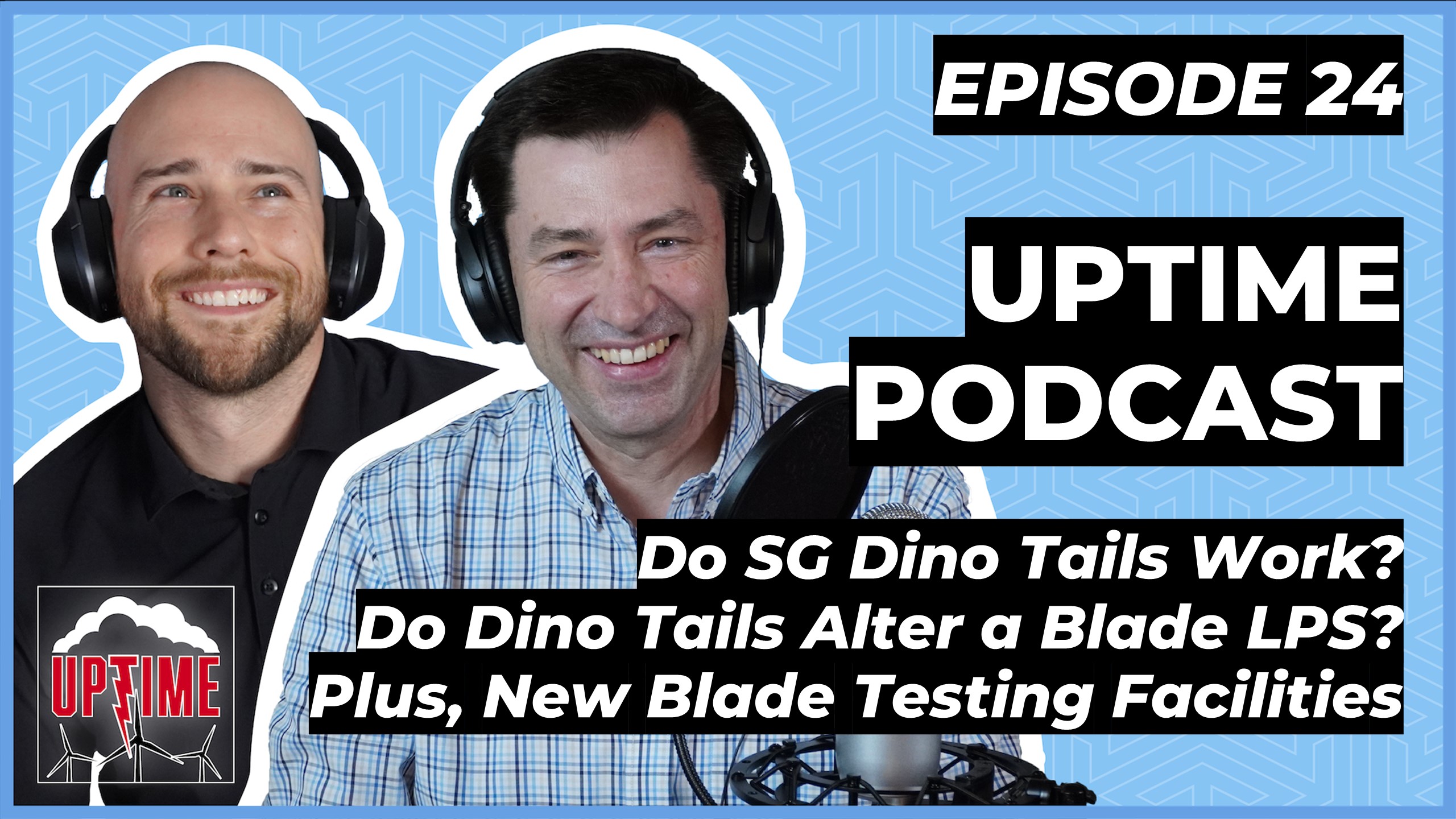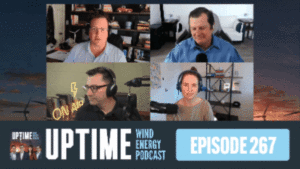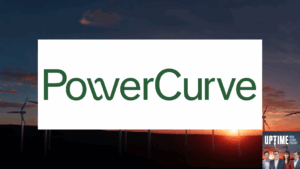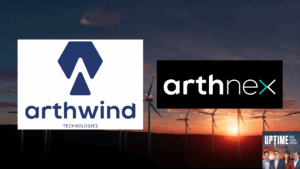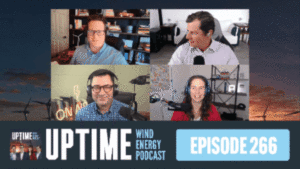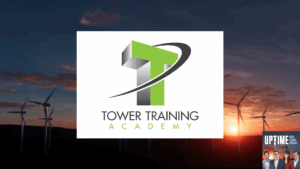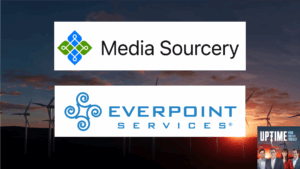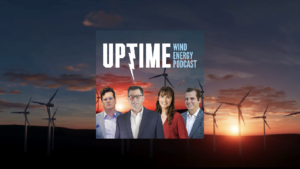In this episode we discuss the effectiveness of trailing edge serrations, (branded as Dino Tails by Siemens Gamesa), and how they also change the lightning strike profile of turbine blades. Watch the YouTube version here. We also explored blade testing and what new, bigger facilities might mean for accurate testing of ever-increasing, mammoth wind turbine blades. Lastly, GE has been in a patent dispute with a number of other wind turbine manufacturers, and we explore the ramifications of continued litigation for all the involved companies.
Learn more about Weather Guard Lightning Tech’s StrikeTape Wind Turbine LPS retrofit. Follow the show on YouTube, Twitter, Linkedin and visit Weather Guard on the web. Have a question we can answer on the show? Email us!
Podcast: Play in new window | Download
Full Transcript – Uptime EP24: Dino Tails, Trailing Edge Serration Tech & Advances in Blade Testing Centers
Dan: This episode is brought to you by Weather Guard Lightning Tech. At Weather Guard, we make wind turbine lightning protection easy. If you’re a wind farm operator, stop settling for damaged turbine blades and constant downtime. Get your uptime back with our strike tape lightning protection system. Learn more in today’s show notes or visit weatherguard.com/striketape.
Allen Hall: Welcome back I’m Allen hall.
Dan: I’m Dan Blewett. And this is the uptime podcast where we talk about wind energy engineering, lightning protection, and ways to keep your wind turbines running.
All right. Welcome back to the uptime podcast. I’m Dan Blewett and I’m joined here remotely by lightning protection expert Allen Hall. Allen, how are you?
Allen Hall: Great Dan, another busy week, a lot of things in the news. What do you, what do you got at the top of the list?
Dan: So today in our episode, [00:01:00] we’re going to talk about, uh, the patent dispute between GE and Siemens Gamesa, renewable energy.
Um, there’s some interesting news about new testing facilities, potentially opening up in the future. Um, we’re going to talk about a pretty interesting wind, uh, prototype that could potentially handle typhoon winds. And lastly, we’re going to talk a bunch about dyno tails and their, uh, inspiration from the owl, which Al’s are just such awesome creatures.
They’re just amazing. But anyway, a dyno tales are pretty interesting. They reduce the noise. And a, of obviously turbine blades create a lot of noise or slicing through the air so fast. And if they reduce this noise, then they can potentially operate a higher speeds and still be in compliance with local laws.
So we’ll chat a little bit about that. So, yeah, it’s been busy, Alan. How, uh, how are things up there in Massachusetts?
Allen Hall: Oh, it’s summertime we’re we’re, uh, trudging along, uh, take a little ride up to, uh, Vermont. Uh, check out some of the wind turbine sites up there. There’s, there’s a number of wind turbine sites have been added in the last five years, I’d [00:02:00] say.
Uh, so there’s a lot of different varieties of wind turbines locally. And obviously even across the United States, pretty much, uh, within an hour’s drive or so you’re going to be able to find wind turbines in the States. It’s, it’s a very active marketplace right now.
Dan: What are the biggest sizes up by you?
You see a pretty wide range. Are they all pretty, pretty steady?
Allen Hall: 45 meter, 15 meter blades is, but be about the biggest we see up here. I think that’s a factor of, uh, just the weather, the winter conditions tend to limit that and, and the, the mountaintop rural locations that these get installed in.
Dan: Yeah.
Gotcha. So, Speaking of, uh, you know, high market share in the U S GE, which is, I think still number one, or they’re, they’re getting maybe caught by Vestas in the U S uh, GE is defending their, uh, one of their licensing agreements with other turbine companies. So they’re in a dispute between Siemens Gamesa.
And, um, [00:03:00] this looks like it’s going to get a little bit Tessy, what’s your take on the lawsuit between. Um, GE and Siemens
Allen Hall: Gamesa. Well, clearly GE has a patent and it seems like Gamesa, at least in theory, I know both sides are going to dispute this as in violation of that patent. So the way this plays out is, uh, wherever you have patent protection, you can defend that patent.
And just make it real simple here. So if GE being a us based company, uh, wants to enforce their patent on us territory, that means Siemens Gamesa pretty much can’t offer that technology in the United States or if they do, um, they can, you know, G can go all the way and try to get some solar embargo or. Uh, stop the shipments from happening and then impose fines, get, they asked the federal government to impose fines and it can get ugly fast, uh, especially when got big players and both, both sides have attorneys number.
I’m sure several attorneys firms locked
Dan: up.
Allen Hall: Yeah. They have armies of attorneys, [00:04:00] unlike small businesses, which just can’t afford that GE and Siemens Gamesa totally can. So they can go to. To legal battle for a long time. The, the problem is, uh, at least in the United States, the companies have learned that if they bring the federal government government into, uh, act on their behalf and enforce these, uh, patent rulings, that it puts a real financial strain on the other company.
So you don’t really have to win the argument. You just have to get the federal government to sort of. Back your side. And when you got a us based company and a international company coming together, well, you know how the U S is gonna go and that, so it creates these impediment it’s to, for business to happen.
And it doesn’t make a lot of sense to let those go on the best for both sides is just to negotiate it and come to an agreement. And somebody pays somebody else and move on. I think that’s eventually where I was going to get to, but being in this sort of economic environment, we were in, [00:05:00] uh, the, that may not be as easy as it seems, because that’s the way it’s mostly played out.
If you’ve watched, uh, Microsoft or some of these software companies get involved in lawsuits for patent infringement, Apple being another one. They can trudge on for years. And finally there’s involve the federal government and try to put the hammer down. That’s where it starts to make a turn. So GE could probably use a little bit of help right now, honestly, just because, um, you know, their stock price is so low and financial strain at their end that they’re going to take this one to the map probably.
Dan: Yeah. Well they say almost all of Siemens gun Mesa’s us turbines are in infringement according to the complaint. So yeah, they’re gonna. Take a good chunk of change off them. If they can continue to get either royalties or, or whatever the agreement ends up being. So yeah. GE is definitely hurting.
Yeah.
Allen Hall: If, but own those wind turbines in the States, you don’t want to be in that situation where a GE can in theory, start finding you or shut you down. And. [00:06:00] That’s just, that’s just bad. It’s just bad for them, for the industry as a whole. You don’t want to see those to Duke it out at the local level. That that will be no fun for anybody.
So it’s better resolved, um, across a conference room table somewhere, but it doesn’t seem like that’s going to happen immediately. At least reading the articles, the recent articles about it.
Dan: Yeah. So let’s, let’s shift a little bit, obviously we’ve talked a bunch about testing and lightening standards and lightening standards or.
Pretty lax, especially according to, uh, some companies like DNV GL who are pushing for, you know, more rigorous standards with which to certify things. But this article for wind power engineering is talking about there’s a new blade testing center, uh, open in 2017. And some of these older standards in 2014 are getting pretty outdated because blades have become just so huge in such a short period of time.
I mean, even in six years, they’ve really grown. So. Well, what I mean, you’ve done lighting, testing extensively in the [00:07:00] aerospace industry. What are the challenges behind getting a new UpToDate facility of this size?
Allen Hall: Well, they got a couple of problems. Uh, anytime you’re trying to keep up with industry. Uh, in terms of the size of anything, uh, this particular case as the wind turbines start to incorporate more and more carbon fiber, the strength of the carbon fiber allows the plants get longer and longer and wider and wider.
So from a structural standpoint, you need a facility to handle that. And that’s hard to come by because those, those facilities don’t get used at all, not often. Uh, but when they need to get, usually need to get used and they got to keep up with the current rate of technology and the infrastructure investment is really left up to the local or state or federal governments across the world to support this stuff because there’s really no.
Private investments can be able to keep up with the rate of advancement that these blades are making. So on the lightening side, as we’ve seen [00:08:00] with some of the lightening test facilities around the world, as we’ve been testing longer and longer sections of blades, the facility has gotten bigger and bigger and bigger.
Uh, and the United States, um, lightning too , which is now in Ts, uh, several years ago, built a fairly large high voltage test facility. But even now that’s still, you kind of press the limits there on its size, where the blades continue to grow. Uh, Polytech over in Denmark has a very large lightening facility, but on the structure structural side, You’re testing, essentially full length blades.
And you’re trying to put mechanical stresses and sort of lifetime tests. These, these blades by pulling, pushing, uh, twisting, trying to put a wind loads on them without actually when loading them. So you gotta create this mechanical environment where you can stress these things, just imagine. So these blades are laying on their side, so you gotta have just basically a huge amount of concrete and up and up Mount on one end.
And you can Mount the blade up to horizontally and then the blades running across the facility. And then [00:09:00] you got to hook actuators and hydraulic actuators, that pole twists move in a manner that’s SIM simulates, uh, use on an actual winter when somewhere that’s not easy to do, it takes a lot of computer technology and a lot of engineering just to simulate those loads and to predict those loads and then to apply them.
Uh, is it just a whole nother level? But as this little article talks about, uh, what does say dance at one and 200 blades fail a year, like a half a percent? Uh,
Dan: yeah, it’s just crazy.
Allen Hall: That’s a large number. Cause there’s a lot of to replace out in the world. Now fail as we were discussing earlier, fail can mean anything from fall off, hit the ground to have some sort of a mechanical failure where the blade buckles or splits or something of the sort.
So it doesn’t have to mean necessarily. Huge catastrophic, but one in 200 is still expensive. So what is that number really correct. And if it is correct, [00:10:00] then the mechanical testing that happens at these facilities really needs to be, uh, ramped up in forest verified, validated. Cause one of your biggest problems is.
You can predict what the outside world looks like mechanically, but you never really know till you get out there and you watch how some of the failures are occurring. And then the engineers stumble around and try to figure out what has happened to these broken blades and then incorporate it into some sort of.
Usually a company test standard, which gets applied at these test facilities. So it’s like a constant control loop of a designed the blade best. You can do some testing on it, limited testing to make sure it doesn’t really want to come apart, put it out in the field and watch it if it does come apart and you get back in that loop again, where you’re coming back and I’m trying to evaluate why that happened and how you got there, test it.
So you can validate that the next series. So it’s not the, it’s not the easiest thing in the world to do. And. Every part of this is really, really expensive millions and millions and millions of [00:11:00] dollars for these facilities. And it’s just, it’s just hard, no way of getting around. It’s just hard.
Dan: Well, and I guess as you’re talking, I’m thinking why don’t some of the companies like the big players, like the Siemens Gamesa, the GE, I mean, is there a way for them to all sort of, sort of share the burden and create an independent lab that they fund.
Um, you know, maybe they all back a major university, like this was, you know, university in Denmark, but TTU, why isn’t there some collaborative effort?
Allen Hall: There is there isn’t some level, um, like the state of Massachusetts where I’m, where I’m at has a winter man test facility, blade test facility, uh, near the ocean actually.
Uh, they built that a couple of years ago and I’m sure it’s outdated already. Well, there’s not a, well, I guess in Rhode Island is a blade manufacturing facility TPIs down in Rhode Island. So somewhere close as a blade manufacturing facility, but yeah, you’re going to need to have investment. And I think the way that the local governments, at least in United States look at it as if they [00:12:00] put those facilities in their States to do the testing.
That kind of means you need to be doing. Either engineering or engineering and manufacturing for blades in your state. Like you make it a, um, a reasonable place to plant to put your plant. So sometimes the, the ma the, the test facilities land first, and then the, and to encourage the manufacturers to come there later.
It’s hard to make them pay for that up front, but you are making them pay for testing. There’s no doubt about that. You know, you’re going to be take occupying that facility for a hundred days. You’re going to pay for a hundred days of, of test time. And that will not be cheap, but if you can think about it, I I’d be hard pressed to think that those facilities are used.
50% of the time, 70% of the time, most lightening lightening labs and structural test labs on, on smaller components are busy, but there’s not always one. They’re not, they’re not 100% busy all the time. I just, [00:13:00] there’s just not, it’s just not the way things work.
Dan: We’re going to jump to our engineering segment. And first thing on our docket today is the Enercon . So this is a, a wind turbine that just had its first successful installation. Um, in Belgium and, uh, this is interesting because they said it can take wind up to 89 meters per second, which is a about typhoon speeds.
And, uh, I mean, this seems pretty crazy. I mean, we, we talked about the typhoon turbine, which is literally called the typhoon turbine by a different company back in an earlier episode of the show. And, uh, but this is like a pretty standard design. This isn’t, you know, this looks like a normal wind turbine, but what do you think, uh, the technology is here.
That’s going to help us with stands at high speed without breaking apart. I mean, what do they have to bolster tower?
Allen Hall: Blades, nacelle,
Dan: Pad… just all that [00:14:00] stuff. Just all of it.
Allen Hall: Yeah. I think it’s going to be all of it. Uh, that’s one thing about any sort of strong winds, like it’s hurricane season in the United States.
And so we’re starting to have hurricanes pop up on the Southern Eastern Southeastern coast. Is those winds swirl. Right. So you really can’t tell what direction they’re going to come from necessarily. And you gotta be able to take the, just a total wind load on the towers and the blades and everything else, and transfer that load into the earth under the ground.
And I have the whole thing just topple over. That’s not easy to do so probably every single component. Of the structure is going to have, uh, enhancements to, to withstand these more than likely. Yes. Uh, this type of wind turbines, obviously it’s just gonna use in select areas because it’s going to cost more to make, it’s going to take more manufacturing, more raw materials, more of everything, uh, to, to produce this wind turbine.
So it’s going to have limited uses, but as we, no, right, right now there’s a lot of play. Yes. As long as the United States and a lot of [00:15:00] coastlines where. Uh, around the equator weather in California, you name it. Uh, there’s just a lot of strong winds and really horrible weather. And if you’re going to try to produce, uh, electric, clean electric energy, you’re going to have to be able to make wind turbines.
They can tolerate that thing. So my question is where do they test all this? Test it all. And how are you going to validate it? I think that would be my biggest concern is. Myths is it, is it proven technology? Is that something that they’ve developed over time? And they had some test beds and they said, yeah, we we’ve stuck it out.
And, uh, the ocean and the ditches. Great. And then we’re going to extrapolate that out and, and continue on with this concept. I don’t know. I kind of wonder how that, how that’s going to work. Right. Cause you’ve got this really niche market and then you’re trying to. Could take it over, but there’s gotta be some confidence on the insurance side that we don’t have an issue, right?
Dan: Yeah. Well, this is, and this is the prototype they are they’re installing. So this [00:16:00] is, I think this is that moment where they’re going to see does this actually work? And as we discussed with some of the floating stuff, or like, you just don’t really know until it actually gets into typhoon. Yeah. So I guess if, I guess
Allen Hall: we’ll see.
Yeah. The thing too, Dan, I know in the United States, one of the issues for hurricanes is a lot of flying debris. Right that a lot of it, a lot of the damage that happens to homes, buildings, uh, vehicles is not so much, uh, the winds, so to speak, but it’s all the, the houses that they get broken up into wooden two by fours.
Flying around on a hundred miles an hour and getting shoved through cars and everything else and windows that’s really hard to take. Have they thought obviously the tower can probably take it because it’s steel, but can the blaze take that or do they think they’re going to have blades take damage of flying debris?
Possibly.
[00:17:00] Dan: All right, Allen. So let’s talk a little bit about dyno tales. So obviously this is actually, this is not the official term for, this is a Siemens Gamesa brand name. Um, for what’s basically, I guess it doesn’t seem to have a universal name in, in the wind turbine industry, but it’s trailing edge serrations or trailing edge feathering.
Um, and this is sort of like one of a group of, uh, I guess, power curve upgrades, but can you take us through a little bit about what a dyno tail or what a trailing edge duration does? A two wind turbine blade?
Allen Hall: Sure. So when a wind turbine, uh, flies blade flies to the air, Yeah. If you think about this way, the, and any sort of wing or blade though, the air going over the top surface is moving faster than the, in the air on, on the flat bottom surface.
So there’s a high pressure on the bottom. There’s low pressure on top and those two. Uh, sheets of air meets on the trailing edge of the blader wing. So you’ve got this sort of fascia moving air on top and the slow moving air in the [00:18:00] bottom, and they have to come together. And when they come together, they create turbulence and that turbulence you can actually hear.
So it’s the sound you hear when a winter and blade rotates through the sky. It’s got that rustling noise, that wispy wispy noise that you hear. So there’s turbulence there at anytime you have turbulence coming off a blade either. Yeah. During the, in the span or on the tips. And the tips is where you kind of see it, the most is turbulence is drag and, uh, it’s also noise.
And if you are placing wind turbines in places where it’s noise sensitive as close to a local town or city and there’s noise requirements, it’s hard to make those wind turbines operate a full power without trying to put in some quieting devices on them. Well, these feathers are a one way of doing that because it takes the air on the top of the blade and the bottom of blade and kind of mix them together gently.
Much like a bird. Feather does cite Al always example. I hear all the time as ALS [00:19:00] Al feathers. When you watch an Al flag, you’re watching out flight at nighttime. You can’t, you can’t hear that thing fly it’s
Dan: fairly. No one sees them flop. Yeah, no one sees them fly. They’re like little ghosts. Oh no. I see an alpha fly
Allen Hall: in your life.
Dan: No. Oh yeah. See, I was fly.
Allen Hall: Yeah. My backyard
Dan: all the time. Just such, they’re just such good elusive predators that you just you’d never know they’re there. And to actually see them take flight, I feel like it’s pretty rare for these. And the right place, right time.
Allen Hall: And in our little neck of the woods, there’s a lot of little creatures running around in the grasses and the Alison good
Dan: eyesight too.
Yeah. All right. All right, so I’m wrong, but all right. So, so back to ALS. So are they the only birds? I mean, a lot of birds probably have this quote unquote technology, natural selection. That’s helped them just fly quieter. Right.
Allen Hall: All right. Quiet or stealthy. Right then the little mouse didn’t hear you coming.
That’s essentially it.
Dan: Gotcha. So it sounds like the main advantage here is just, I guess a lot of turbines are, are essentially limited. Like [00:20:00] they can’t operate a full speed because otherwise they wouldn’t comply with local noise regulation. So now this just allows them to take the limiter off and, and.
They get more power that way. It seems like a no brainer. So why, why? I mean, if you look around the web and you search for images of wind turbines, you don’t see many, I mean, it’s hard to find it’s hard to find a photo with these feathers on it. I mean, well, what’s the prevalence look like right now? I mean, how, how many of these are out there with these owners?
Allen Hall: Well, Siemens Gamesa has been offering them or Siemens in particular has been offering it for a couple of years. What. Is happening now, as we talked about as wind turbines age and the, and the percentage drop off in power production occurs what’s happening is there’s like a, there’s like a secondary market there to bring the blades back to better efficiency or higher efficiency as the age to basically recover some of that power out.
But you lost, you put some of these enhancements on, so these power curve upgrades include. The feathers on the back end and the F and the feathers can give you another, [00:21:00] maybe another percentage point back of a power that you otherwise wouldn’t be able to get. So what’s happening now is you see a lot of the manufacturers or companies like Polytech that are upgrading blades that are five, 10 years old with feathers to improve their efficiency.
That that’s what’s happening now. I don’t really see a lot of this coming out of the factory. Like I. Like today. I really haven’t seen a lot of them coming up factory. It seems like the energy production coming on the factory is pretty good. And as the, uh, operators watch that power curve as they do every day.
Yeah. They’ll see that gradual decline at some point, it makes sense to make that upgrade. It’s usually five to 10 years into the life span of the thing and then ride it out. The remaining lifetime of the blades. So it, it makes sense. Uh, but you also got into a wonder if you put it on at year zero, how long they’re going to last, right?
So it may not, it may not last a full 20 years and mayor that’s [00:22:00] smarter to put it on at your seven, eight, nine, 10, something like that to get the remaining lifetime out of it. It’s a cost benefit analysis and there’s a lot of, uh, good. Site management that has Excel spreadsheets that has calculated that and determine what the right timeframe is and the lifetime of those blades.
No doubt.
Dan: Yeah. Gotcha. Well, I’ve got a couple of questions that are lightening really to obviously anytime you modify. The aerodynamics of the blade, you’re gonna just affect the way it interacts with the air and the environment and all that stuff. And that includes lightening. So, um, being that you’re our lighting protection expert.
What do you see the implications of this being? Number one? Is it going to change the location of strikes on the blade?
Allen Hall: Yes. No doubt. And we’ve already seen that. We’ve seen it from multiple reports over the last, Ooh, three, four years, uh, 2017. But the first time I saw some of this coming in, yes, it does. Uh, if you think about it, no blade is.
Clean. Right. So when you put these [00:23:00] feathers on the, on the back end, you got this basically bumpy, uh, serrations at the trailing edge of the blade. And they’re made out of non-conductive things nylon. It looks like it’s a nylon something you can injection mold. So it is a non-conductive thing. And the thought process from.
Watching this go on is that, well, I put a non-conductive thing on the package, the blade, it will have no effect on lightening protection, wrong, totally wrong, because eventually those little feathers get dirty. I don’t know if you’ve ever picked up a feather out of your yard, but realizing kind of flipped it around it’s full of dust.
Right? So the, that dust is somewhat conductive and as you get debris and. Atmospheric junk on the blade. And on those little feathers, they become somewhat conductive, not highly conducted, but somewhat conductive. And what we have seen is, uh, lightning, uh, leaders and streamers originating off the edge of those, uh, feathers, typically out towards the outer tip.
But off those feathers. [00:24:00] And then, so it reaches out to the sky off the feathers, and then it reaches back somewhere on the blade. And we were having lightening punctures to down conductors, uh, near the, near the, near the feathers. And the receptors, another meter or two away, further up the blade. So you’re getting these punctures happening around with the feathers occur and that was clearly not seen or experienced or thought of until, you know, obviously it’s been happening in the field.
I know that some of the OEMs have looked at that and we’re trying to address it. And that’s the right thing to do. Right. Are you getting feedback from the field saying, Hey, we’re having these weird lights strikes and we’re having damage to the blades and place who didn’t envision, what can, what can we do?
No a lot of times actually they reach out to us and, and use a strike tape or lightening diverters to, uh, basically take the receptor and let it reach down down to where the feathers are. So if there’s any electrical activity happening at the feathers, the strike take cash, it brings it back to the receptor.
Thereby sparing damage to the blade. Uh, so there’s, uh, there’s a lot of activity [00:25:00] revolving around that because the, the enhancements that the performance had happened to because of the feathers, you still want to keep, but you just need to make sure you don’t damage the blade from lightning strikes in the meantime.
So,
Dan: uh, what would you do to modify the, the LPs the lightning protection system? Once dyno tales are installed? Cause. Foreseeably you’d want to. All right. We’re going to install these on our turbine. We would want to upgrade our LPs at the same time. Is that right?
Allen Hall: Yes, definitely. So, so you have a little, you have a couple of things to deal with on the larger blades, will they have receptors on the trailer and you add on, uh, feathers back there?
That means you gotta be shoving lightening to those receptors through the feathers. And that’s not always good because you can knock section. Those feathers comes in sections that can be glued on, and it’s in sections roughly a meter long section. You can start knocking off sections of feathers unless you’re careful.
Uh, what we have seen mostly though, is lightning strikes occurring on the edge of the feathers. And then, uh, just randomly puncturing the blade. Now I think that [00:26:00] the best thing we, well there’s. Two things it’s puncturing a blade with a doubt. Conductor is or better yet it, the lightening comes off. The feathers just starts looking for the drain hole and finds a drain hole, then blasts through the drain hole to get to the down conductor.
So you kind of got, you got trained hole damage and damage way up in the blade. Yeah, it’s a problem. So that what we have suggested in our are implementing on a, on a number of wind turbines. Um, this, this has happened across the world at this point. That’s what they’re doing is they’re. Bringing strike tape, lightening diverters from the receptors back towards the trailing edge, uh, trying to protect the drain hole.
And it is very, actually very effective at protecting the drain hall. So it’s trying to catch the lightening strikes. That’s originate at the feathers and trying to direct it around the drain hole and away from the down conductor inside. Really it’s been really effective. I’ve seen it tested. A couple of times now looks good.
It’s simple because you don’t have to do anything structurally to the blade [00:27:00] besides basically peel and stick a couple of, of strike, take diverters to it. But the result has been really good lab tested and the results from the field indicate the same thing that, uh, we’re seeing really good lightening protection where we have done that, done that mod.
Dan: So to summarize, uh, obviously like the dyno tails or, you know, the trailing edge feathers, trailing edge durations. A pretty worthwhile upgrade. So especially if a wind farm operator is ready to do some maintenance and they’re up there probably makes good sense to put those on, but if they do that, they’re gonna, they need to anticipate having some lightening troubles and they should probably upgrade their LPs at the same time, probably put new segment of lighting diverters on.
Um, and obviously like strike tape, you know, our product is the most durable, so that’s gonna last or outlast, you know, all those other upgrades there. So it seems like the, uh, the, the long and the short of it.
Allen Hall: Yeah. Well, I think it’s also the relative cost here. Right? So w when you put the feathers on, there’s a, there’s a cost of buying the feathers, the cost putting on the feathers, [00:28:00] and then sort of as a secondary thought, like, Oh, what about the LPs?
What am I supposed to do there? Uh, we found that, uh, the strike team addition to. Correct. The, the feather issue is relatively to the cost of the feathers is. Minor. Uh, so you’re up there already to put a couple of pieces of strike tape on takes really no time to do, uh, versus the time you’re taking to put the feathers on.
So in terms of, uh, overall cost to install some strike tape to, to help to protect the feathers from damaging the blade. It’s a minor cost.
Dan: All right, well, we’re going to wrap up today’s episode of uptime. If you’re new to the show. Welcome. If you’re a regular here, thank you for your continued support.
Please subscribe to the show and leave a review on iTunes, Spotify, or wherever you listen to podcasts. Don’t forget to check out the weather guard, lightening tech YouTube channel for video episodes, full interviews and short clips from each show for Allen and all of us at weather guard. Stay safe. And we’ll see you next week
[00:29:00] is downtime causing you financial pain and putting a stop to your power production for months on end. It’s no secret lightning strike damage is a major cause of wind turbine downtime. This damage is preventable with our easy to install, strike tape lightning protection system for wind turbine blades are incredible engineering, build quality materials and edge sealants.
With stand up to five times more abuse in the toughest weather enlightening conditions, and we’ve got the research to prove it. If you’re tired of constant downtime, we can help reach out to us at weather guard, wind.com and schedule a free call. We’ll get your uptime back in no time.



